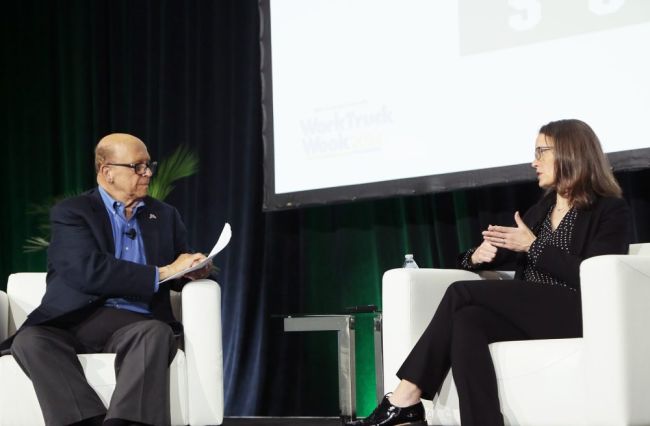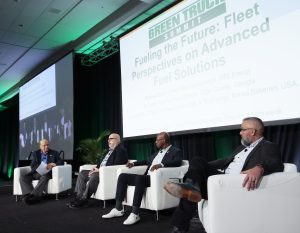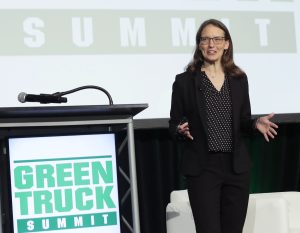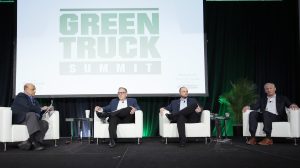
6 Takeaways from the 2024 Green Truck Summit
Over 800 fleet professionals and industry representatives attended the daylong Green Truck Summit – part of NTEA’s Work Truck Week in Indianapolis – on March 5 to assess the current landscape and path forward for electrification.
So, what is the outlook for electric trucks?
In a nutshell, truck manufacturers are still investing heavily in new electric models. But the lack of a comprehensive charging network, the high upfront cost and limited product options are creating bottlenecks to widespread adoption.
Mary Aufdemberg, general manager of product strategy at Daimler Trucks North America, struck a candid yet optimistic tone in her keynote, saying that “collectively, we can make this happen” through determination and collaboration. But her remarks, along with insights from other speakers, underscore the obstacles ahead.



Here are six key takeaways from the summit’s general sessions.
1. No silver bullet.
Developing zero-emission trucks across a wide range of commercial vehicle classes, applications and duty cycles is the most significant technological hurdle confronting manufacturers, Aufdemberg said.
“It takes a lot to cover the complexity of the vocational market,” she said. “It takes a lot to cover the complexity of the entire truck market when you think about all of the different use cases, all of the different applications, power needs, torque curves, you name it.”
2. The continued need for incentives.
Aufdemberg said incentives are still needed in the early adoption phase to make the business case work financially for fleets.
“For sure, the total cost of ownership and operation of EVs has a very new formula that we’re all figuring out,” she said. “I’m also not going to stand up here and pretend that grants and incentives are not a part of the game. To make it work today, we absolutely understand the need for those grants and incentives to make this work.”
3. Infrastructure constraints.
“Today, there are 10 public infrastructure sites for medium- and heavy-duty commercial vehicles. Compared to 60,000 car sites from a charging perspective. That is a huge challenge for us to solve,” Aufdemberg said. “Every single time a customer or one of our dealers wants to start looking at putting in infrastructure, the formula, the process, the permits, the costs, the availability of power to that space is completely different and the formula changes every time.”
To tackle the infrastructure problem, Aufdemberg said Daimler is investing in initiatives like:
- Public charging hubs through partnerships like Greenlane for truck-specific corridors.
- The recently formed PACT (Powering America’s Commercial Transportation) with Volvo and Navistar to accelerate infrastructure deployment through policy advocacy.
- Joint ventures on production such as the battery plant with PACCAR and Cummins.
- Providing consulting services to help customers and dealers navigate the complexities of deploying private charging.
- Contributing to standardization efforts for megawatt charging.
Regarding the need to develop global charging standards, Aufdemberg said, “We have to solve both for today and the future. With technology constantly changing, that becomes one of the challenges: helping make sure we have standards today but looking to the future.”
4. EV market growing pains.
Eric McCann, director of fleet sustainability and technology at Bimbo Bakeries USA, highlighted how quickly EV technology is evolving, making some parts outdated.
“I would have never thought I would have said that, but the rate at which the EVs are advancing – let me use the word ‘advancing’ – it’s very concerning,” he said. “There’s a lot of proprietary parts. They’re growing. This part’s getting outdated. If you’ve got a part that’s proprietary on a truck, and then it’s no longer used. I mean, yeah, Daimler’s gonna be around a while, but these other companies, how does it all sort out?”
Al Curtis, fleet services director for Cobb County, Georgia, mentioned the need for more consistency from OEMs on which EV models they’ll continue producing.
“We started out with the Chevy Bolt and did really well,” Curtis said. “Then they said they were going to stop making it. And then they came back and said, well, they’re going to make it again. Just some consistency and just continue to make vehicles that [allow us to] standardize the fleet.”
5. Being proactive with managing expectations.
Matthew Betz, expert – fleet optimization at DTE Energy, highlighted the collaboration between fleet and DTE’s change management department to help smooth the transition to EVs.
“We had a specific strategy to explain the change, what it was going to mean to [drivers, technicians, the business leaders and everyone impacted], why we were doing it, so that they could see our goals and fleet were tied to the organization’s goals on overall emissions reductions,” he said.
McCann discussed the importance of getting frontline drivers comfortable with the new EV technology.
“As soon as it fails, it’s ‘I told you so,’ and now they want to jump in their rental or their spare, and they run around on the gas,” McCann said. “So, it’s really trying to keep our drivers knowing that we’re at the forefront. We’re trying to be the tip of the spear. We know we’re going to fail.”
McCann stressed transparency and incorporating driver feedback to build ownership, saying, “They’re also giving us suggestions. And we’re making sure that we’re implementing it.”
6. Combustion engines not going anywhere – yet.
Gordon Wolverton, director of zero-emissions powertrain technology at Navistar, highlighted their new 15% more efficient S13 integrated diesel powertrain as “meant to minimize that impact to help our customers transition through the combustion engine regulations.”
“We have to recognize that when you burn something, it still creates emissions,” he said. “And so, we can’t ignore that fact, and we can’t ignore that our customers are going to continue to use them. So, we have to participate.”
The Bottom Line
Aufdemberg acknowledged that the pace of electric truck adoption has progressed “a little bit slower” than predicted, partly due to infrastructure delays. However, she insisted that innovative partnerships and a mindset of “worth-it work” would ultimately propel the industry through the transition.
“We don’t still have all the answers, but we are working on solutions,” Aufdemberg said. “It’s a journey that we are all a part of. With the complexity of vehicle types, the customer needs and the ecosystem challenges, there’s no easy button. But there is a will. And behind that will, there’s action. And that’s critical.”

